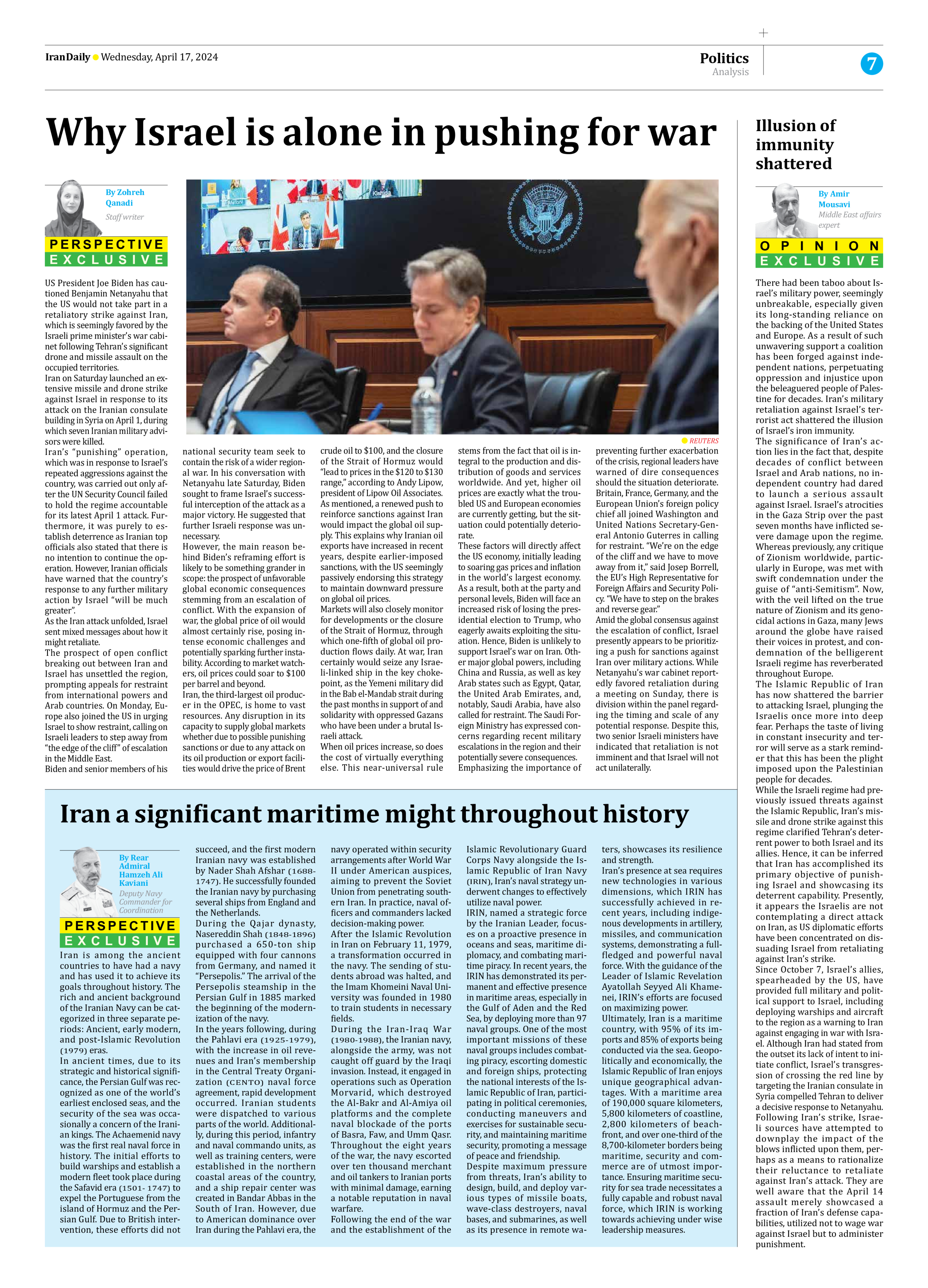
Iran a significant maritime might throughout history
By Rear Admiral Hamzeh Ali Kaviani
Deputy Navy Commander for Coordination
Iran is among the ancient countries to have had a navy and has used it to achieve its goals throughout history. The rich and ancient background of the Iranian Navy can be categorized in three separate periods: Ancient, early modern, and post-Islamic Revolution (1979) eras.
In ancient times, due to its strategic and historical significance, the Persian Gulf was recognized as one of the world’s earliest enclosed seas, and the security of the sea was occasionally a concern of the Iranian kings. The Achaemenid navy was the first real naval force in history. The initial efforts to build warships and establish a modern fleet took place during the Safavid era (1501- 1747) to expel the Portuguese from the island of Hormuz and the Persian Gulf. Due to British intervention, these efforts did not succeed, and the first modern Iranian navy was established by Nader Shah Afshar (1688-1747). He successfully founded the Iranian navy by purchasing several ships from England and the Netherlands.
During the Qajar dynasty, Nasereddin Shah (1848-1896) purchased a 650-ton ship equipped with four cannons from Germany, and named it “Persepolis.” The arrival of the Persepolis steamship in the Persian Gulf in 1885 marked the beginning of the modernization of the navy.
In the years following, during the Pahlavi era (1925-1979), with the increase in oil revenues and Iran’s membership in the Central Treaty Organization (CENTO) naval force agreement, rapid development occurred. Iranian students were dispatched to various parts of the world. Additionally, during this period, infantry and naval commando units, as well as training centers, were established in the northern coastal areas of the country, and a ship repair center was created in Bandar Abbas in the South of Iran. However, due to American dominance over Iran during the Pahlavi era, the navy operated within security arrangements after World War II under American auspices, aiming to prevent the Soviet Union from penetrating southern Iran. In practice, naval officers and commanders lacked decision-making power.
After the Islamic Revolution in Iran on February 11, 1979, a transformation occurred in the navy. The sending of students abroad was halted, and the Imam Khomeini Naval University was founded in 1980 to train students in necessary fields.
During the Iran-Iraq War (1980-1988), the Iranian navy, alongside the army, was not caught off guard by the Iraqi invasion. Instead, it engaged in operations such as Operation Morvarid, which destroyed the Al-Bakr and Al-Amiya oil platforms and the complete naval blockade of the ports of Basra, Faw, and Umm Qasr. Throughout the eight years of the war, the navy escorted over ten thousand merchant and oil tankers to Iranian ports with minimal damage, earning a notable reputation in naval warfare.
Following the end of the war and the establishment of the Islamic Revolutionary Guard Corps Navy alongside the Islamic Republic of Iran Navy (IRIN), Iran’s naval strategy underwent changes to effectively utilize naval power.
IRIN, named a strategic force by the Iranian Leader, focuses on a proactive presence in oceans and seas, maritime diplomacy, and combating maritime piracy. In recent years, the IRIN has demonstrated its permanent and effective presence in maritime areas, especially in the Gulf of Aden and the Red Sea, by deploying more than 97 naval groups. One of the most important missions of these naval groups includes combating piracy, escorting domestic and foreign ships, protecting the national interests of the Islamic Republic of Iran, participating in political ceremonies, conducting maneuvers and exercises for sustainable security, and maintaining maritime security, promoting a message of peace and friendship.
Despite maximum pressure from threats, Iran’s ability to design, build, and deploy various types of missile boats, wave-class destroyers, naval bases, and submarines, as well as its presence in remote waters, showcases its resilience and strength.
Iran’s presence at sea requires new technologies in various dimensions, which IRIN has successfully achieved in recent years, including indigenous developments in artillery, missiles, and communication systems, demonstrating a full-fledged and powerful naval force. With the guidance of the Leader of Islamic Revelation Ayatollah Seyyed Ali Khamenei, IRIN’s efforts are focused on maximizing power.
Ultimately, Iran is a maritime country, with 95% of its imports and 85% of exports being conducted via the sea. Geopolitically and economically, the Islamic Republic of Iran enjoys unique geographical advantages. With a maritime area of 190,000 square kilometers, 5,800 kilometers of coastline, 2,800 kilometers of beachfront, and over one-third of the 8,700-kilometer borders being maritime, security and commerce are of utmost importance. Ensuring maritime security for sea trade necessitates a fully capable and robust naval force, which IRIN is working towards achieving under wise leadership measures.







